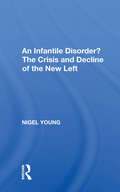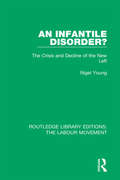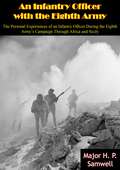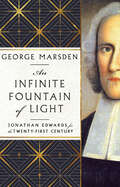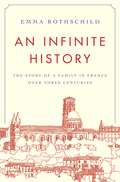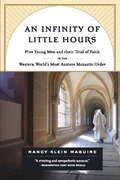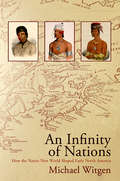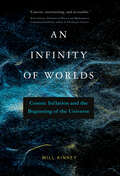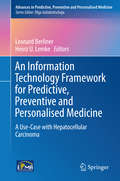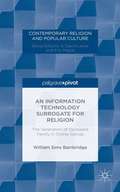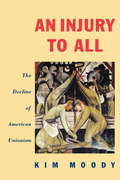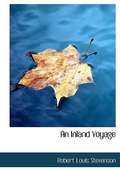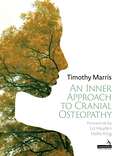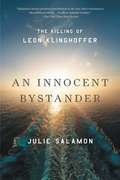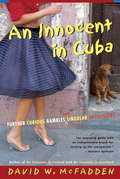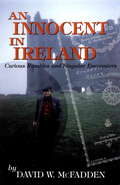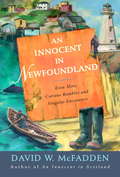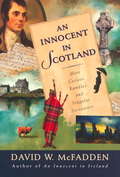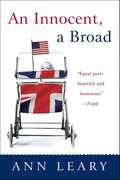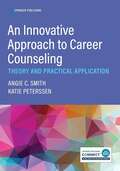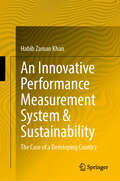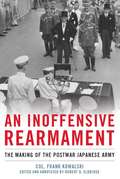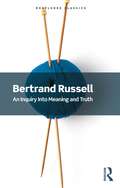- Table View
- List View
An Infantile Disorder?: The Crisis And Decline Of The New Left (Routledge Library Editions: The Labour Movement Ser. #44)
by Nigel YoungFirst published in 1977. The New Left, as an organised political phenomenon, came - and went - largely in the 1960s. Was the Movement that went into precipitate decline after 1969 the same New Left that had developed a decade earlier? Nigel Young's thesis is that the core New Left, as it had evolved by the mid-1960s, had a unique identity that set
An Infantile Disorder?: The Crisis and Decline of the New Left (Routledge Library Editions: The Labour Movement #44)
by Nigel YoungFirst published in 1977. The New Left, as an organised political phenomenon, came – and went – largely in the 1960s. Was the Movement that went into precipitate decline after 1969 the same New Left that had developed a decade earlier? Nigel Young’s thesis is that the core New Left, as it had evolved by the mid-1960s, had a unique identity that set it apart from other Old Left and Marxist groups. He believes that this was dissipated in the later developments of the black and student movements, and in the opposition to the Vietnam war. By 1968 – the watershed year – an acute ‘identity-crisis’ had set in within the Movement and became the major source of the New Left’s disintegration. Nigel Young traces the Movement’s growth and crisis mainly in Britain and America, where it reached its greater strength, but attention is also paid to parallel developments in similar movements elsewhere. He analyses the crisis in terms of the interrelationship between dilemmas of strategy and ideas, and the external events which tend to reinforce the tendencies toward elitism, intolerance and violence, and produce organisational breakdown.
An Infantry Officer with the Eighth Army: The Personal Experiences of an Infantry Officer During the Eighth Army’s Campaign Through Africa and Sicily
by Major H. P. SamwellFirst published posthumously in 1945, this is a descriptive account by Major H. P. Samwell, MC of his experiences serving as an Infantry Officer with the Desert Army in the Western Desert and Sicily between 1942 and 1943.A rare account of the North African campaign as it happened, day-by-day, and includes Samwell’s thoughts from the frontline regarding the problems of occupation in Italy.-Print ed.
An Infinite Fountain of Light: Jonathan Edwards for the Twenty-First Century
by George M. MarsdenChristians need to pause once in a while to get their bearings. For perspective on our own times and how we got here, it helps to listen to wise guides from other eras. In An Infinite Fountain of Light, the renowned American historian George Marsden illuminates the landscape with wisdom from one such mentor: Jonathan Edwards. Drawing on his deep expertise on Edwards and American culture, Marsden explains where Edwards stood within his historical context and sets forth key points of his complex thought. By also considering Benjamin Franklin and George Whitefield, two of Edwards's most influential contemporaries, Marsden unpacks the competing cultural and religious impulses that have shaped our times. In contrast, Edwards offered us an exhilarating view of the centrality of God's beauty and love. Christians' love for God, he taught, can be the guiding love of our lives, opening us to transformative joy and orienting all our lesser loves. "There is an infinite fullness of all possible good in God, a fullness of every perfection, of all excellency and beauty, and of infinite happiness," wrote Edwards. "This infinite fountain of light should, diffusing its excellent fullness, pour forth light all around." With Marsden's guidance, readers will discover how Edwards's insights can renew our own vision of the divine, of creation, and of ourselves.
An Infinite History: The Story of a Family in France over Three Centuries
by Emma RothschildAn innovative history of deep social and economic changes in France, told through the story of a single extended family across five generationsMarie Aymard was an illiterate widow who lived in the provincial town of Angoulême in southwestern France, a place where seemingly nothing ever happened. Yet, in 1764, she made her fleeting mark on the historical record through two documents: a power of attorney in connection with the property of her late husband, a carpenter on the island of Grenada, and a prenuptial contract for her daughter, signed by eighty-three people in Angoulême. Who was Marie Aymard? Who were all these people? And why were they together on a dark afternoon in December 1764? Beginning with these questions, An Infinite History offers a panoramic look at an extended family over five generations. Through ninety-eight connected stories about inquisitive, sociable individuals, ending with Marie Aymard’s great-great granddaughter in 1906, Emma Rothschild unfurls an innovative modern history of social and family networks, emigration, immobility, the French Revolution, and the transformation of nineteenth-century economic life.Rothschild spins a vast narrative resembling a period novel, one that looks at a large, obscure family, of whom almost no private letters survive, whose members traveled to Syria, Mexico, and Tahiti, and whose destinies were profoundly unequal, from a seamstress living in poverty in Paris to her third cousin, the cardinal of Algiers. Rothschild not only draws on discoveries in local archives but also uses new technologies, including the visualization of social networks, large-scale searches, and groundbreaking methods of genealogical research.An Infinite History demonstrates how the ordinary lives of one family over three centuries can constitute a remarkable record of deep social and economic changes.
An Infinity of Little Hours: Five Young Men and Their Trial of Faith in the Western World's Most Austere Monastic Order
by Nancy Klein MaguireIn 1960, five young men arrived at the imposing gates of Parkminster, the largest center of the most rigorous and ascetic monastic order in the Western world: the Carthusians. This is the story of their five-year journey into a society virtually unchanged in its behavior and lifestyle since its foundation in 1084. An Infinity of Little Hours is a uniquely intimate portrait of the customs and practices of a monastic order almost entirely unknown until now. It is also a drama of the men's struggle as they avoid the 1960s-the decade of hedonism, music, fashion, and amorality-and enter an entirely different era and a spiritual world of their own making. After five years each must face a choice: to make "solemn profession" and never leave Parkminster; or to turn his back on his life's ambition to find God in solitude. A remarkable investigative work, the book combines first-hand testimony with unique source material to describe the Carthusian life. And in the final chapter, which recounts a reunion forty years after the events described elsewhere in the book, Nancy Klein Maguire reveals which of the five succeeded in their quest, and which did not.
An Infinity of Nations: How the Native New World Shaped Early North America
by Michael WitgenAn Infinity of Nations explores the formation and development of a Native New World in North America. Until the middle of the nineteenth century, indigenous peoples controlled the vast majority of the continent while European colonies of the Atlantic World were largely confined to the eastern seaboard. To be sure, Native North America experienced far-reaching and radical change following contact with the peoples, things, and ideas that flowed inland following the creation of European colonies on North American soil. Most of the continent's indigenous peoples, however, were not conquered, assimilated, or even socially incorporated into the settlements and political regimes of this Atlantic New World. Instead, Native peoples forged a New World of their own. This history, the evolution of a distinctly Native New World, is a foundational story that remains largely untold in histories of early America. <p><p> Through imaginative use of both Native language and European documents, historian Michael Witgen recreates the world of the indigenous peoples who ruled the western interior of North America. The Anishinaabe and Dakota peoples of the Great Lakes and Northern Great Plains dominated the politics and political economy of these interconnected regions, which were pivotal to the fur trade and the emergent world economy. Moving between cycles of alliance and competition, and between peace and violence, the Anishinaabeg and Dakota carved out a place for Native peoples in modern North America, ensuring not only that they would survive as independent and distinct Native peoples but also that they would be a part of the new community of nations who made the New World.the continent's indigenous peoples, however, were not conquered, assimilated, or even socially incorporated into the settlements and political regimes of this Atlantic New World. Instead, Native peoples forged a New World of their own. This history, the evolution of a distinctly Native New World, is a foundational story that remains largely untold in histories of early America.Through imaginative use of both Native language and European documents, historian Michael Witgen recreates the world of the indigenous peoples who ruled the western interior of North America. The Anishinaabe and Dakota peoples of the Great Lakes and Northern Great Plains dominated the politics and political economy of these interconnected regions, which were pivotal to the fur trade and the emergent world economy. Moving between cycles of alliance and competition, and between peace and violence, the Anishinaabeg and Dakota carved out a place for Native peoples in modern North America, ensuring not only that they would survive as independent and distinct Native peoples but also that they would be a part of the new community of nations who made the New World.
An Infinity of Worlds: Cosmic Inflation and the Beginning of the Universe
by Will KinneyWhat happened before the primordial fire of the Big Bang: a theory about the ultimate origin of the universe.In the beginning was the Big Bang: an unimaginably hot fire almost fourteen billion years ago in which the first elements were forged. The physical theory of the hot nascent universe—the Big Bang—was one of the most consequential developments in twentieth-century science. And yet it leaves many questions unanswered: Why is the universe so big? Why is it so old? What is the origin of structure in the cosmos? In An Infinity of Worlds, physicist Will Kinney explains a more recent theory that may hold the answers to these questions and even explain the ultimate origins of the universe: cosmic inflation, before the primordial fire of the Big Bang. Kinney argues that cosmic inflation is a transformational idea in cosmology, changing our picture of the basic structure of the cosmos and raising unavoidable questions about what we mean by a scientific theory. He explains that inflation is a remarkable unification of inner space and outer space, in which the physics of the very large (the cosmos) meets the physics of the very small (elementary particles and fields), closing in a full circle at the first moment of time. With quantum uncertainty its fundamental feature, this new picture of cosmic origins introduces the possibility that the origin of the universe was of a quantum nature. Kinney considers the consequences of eternal cosmic inflation. Can we come to terms with the possibility that our entire observable universe is one of infinitely many, forever hidden from our view?
An Information Technology Framework for Predictive, Preventive and Personalised Medicine: A Use-Case with Hepatocellular Carcinoma (Advances in Predictive, Preventive and Personalised Medicine #8)
by Leonard Berliner Heinz U. LemkeThis book explores how PPPM, clinical practice, and basic research could be best served by information technology (IT). A use-case was developed for hepatocellular carcinoma (HCC). The subject was approached with four interrelated tasks: (1) review of clinical practices relating to HCC; (2) propose an IT system relating to HCC, including clinical decision support and research needs; (3) determine how a clinical liver cancer center can contribute; and, (4) examine the enhancements and impact that the first three tasks will have on the management of HCC. An IT System for Personalized Medicine (ITS-PM) for HCC will provide the means to identify and determine the relative value of the wide number of variables, including clinical assessment of the patient -- functional status, liver function, degree of cirrhosis, and comorbidities; tumor biology, at a molecular, genetic and anatomic level; tumor burden and individual patient response; medical and operative treatments and their outcomes.
An Information Technology Surrogate for Religion: The Veneration of Deceased Family in Online Games
by William Sims BainbridgeThis book demonstrates principles of Ancestor Veneration Avatars (AVAs), by running avatars based on eleven deceased members of one family through ten highly diverse virtual worlds from the violent Defiance to the intellectual Uru: Myst Online, from the early EverQuest to the recent Elder Scrolls Online.
An Information Theoretic Approach to Econometrics
by Ron C. Mittelhammer George G. JudgeThis book is intended to provide the reader with a firm conceptual and empirical understanding of basic information-theoretic econometric models and methods. Because most data are observational, practitioners work with indirect noisy observations and ill-posed econometric models in the form of stochastic inverse problems. Consequently, traditional econometric methods in many cases are not applicable for answering many of the quantitative questions that analysts wish to ask. After initial chapters deal with parametric and semiparametric linear probability models, the focus turns to solving nonparametric stochastic inverse problems. In succeeding chapters, a family of power divergence measure-likelihood functions are introduced for a range of traditional and nontraditional econometric-model problems. Finally, within either an empirical maximum likelihood or loss context, Ron C. Mittelhammer and George G. Judge suggest a basis for choosing a member of the divergence family.
An Injury to All: The Decline of American Unionism
by Kim MoodyOver the past decade American labor has faced a tidal wave of wage cuts, plant closures and broken strikes. In this first comprehensive history of the labor movement from Truman to Reagan, Kim Moody shows how the AFL-CIO's conservative ideology of "business unionism" effectively disarmed unions in the face of a domestic right turn and an epochal shift to globalized production. Eschewing alliances with new social forces in favor of its old Cold War liaisons and illusory compacts with big business, the AFL-CIO under George Meany and Lane Kirkland has been forced to surrender many of its post-war gains. With extraordinary attention to the viewpoints of rank-and-file workers, Moody chronicles the major, but largely unreported, efforts of labor's grassroots to find its way out of the crisis. In case studies of auto, steel, meatpacking and trucking, he traces the rise of "anti-concession" movements and in other case studies describes the formidable obstacles to the "organization of the unorganized" in the service sector. A detailed analysis of the Rainbow Coalition's potential to unite labor with other progressive groups follows, together with a pathbreaking consideration of the possibilities of a new "labor internationalism. "
An Inland Voyage
by Robert Louis StevensonAn Inland Voyage recounts a canoe trip Stevenson and his friend Sir Walter Grindlay Simpson made in 1876. Setting out from Antwerp, Stevenson (in the Arethusa) and Simpson (in the Cigarette) paddled through Belgium and France along canals and the Oise River. <P> <P> Much of the travelogue relates adventures the two men had along the way. Some of the more notable incidents include the travellers’ inability to use an Etna stove, watching a marionette show, and “being continually wetted with rain” (p. 91). At one point, Stevenson was left clinging to a tree after his canoe was swept away.Stevenson also describes many of the interesting people he and Simpson met. These included members of the Royal Sport Nautique and a family that lived on a barge.Thoughts on wider issues – such as the French character and politics, religion, and the artist’s role in society – also feature. <P> <P> The text includes, too, several philosophic moments, such as the following: <P> <P> “You may paddle all day long; but it is when you come back at nightfall, and look in the familiar room, that you find Love or Death awaiting you beside the stove; and the most beautiful adventures are not those we go to seek” (p. 121).
An Inner Approach to Cranial Osteopathy
by Timothy MarrisThis book is for the current Cranial Osteopathic practitioner. It looks into Cranial Osteopathy from a more profound 'inner' approach to help the practitioner to understand Cranial Osteopathy from a deeper and broader perspective. The book starts by taking the reader on an 'inner' journey of understanding more about themselves as the practitioner, discussing the 'osteopathic toolbox', and the need to be 'inner centred' when diagnosing and treating. It then looks at aspects of diagnosis - of tissue and fluid states - giving the reader several 'inner' considerations which they should apply when assessing a patient. The book then looks at the whole body and using an 'inner' approach to assess and treat each area. Each chapter gives an overview of the relevant anatomy and discusses the osteopathic relevance and new ways of working. Case studies/clinical experiences are described and 'hands on' exercises, which can be accessed via audio files, are given for the reader to practise. These exercises should be done 'at the treatment table' and will prepare the reader to use the approaches described with their patients. The audio leads the listener through a 'guided tour' of the anatomy and explains the exercise while they use their hands to feel what the author is describing.This guide will help Cranial Osteopathic practitioners enhance their skills, knowledge and understanding to a much-advanced level.
An Innocent Bystander: The Killing of Leon Klinghoffer
by Julie SalamonThe definitive story of one American family at the center of a single, shocking act of international terrorism that "manages to capture the essence of the Israeli-Palestinian conflict"(Dan Ephron) On October 3, 1985, Leon Klinghoffer, a disabled Jewish New Yorker, and his wife boarded the Achille Lauro to celebrate their 36th wedding anniversary with a Mediterranean cruise. Four days later, four Palestinian fedayeen hijacked the Italian luxury liner and took the passengers and crew hostage. Leon Klinghoffer was shot in the head, his body and wheelchair thrown overboard. His murder became a flashpoint in the intractable struggle between Israelis and Arabs and gave Americans a horrifying preview of what it means when terrorism hits home. In this richly reported book, drawing on multiple perspectives, Julie Salamon dispels the mythology that has grown around that shattering moment. What transpired on the Achille Lauro left the Klinghoffer family in the grip of irredeemable sorrow, while precipitating tragic reverberations for the wives and sons of Abu al-Abbas, the Palestinian mastermind behind the hijacking, and the family of Alex Odeh, a Palestinian-American murdered in Los Angeles in a brutal act of retaliation. Through intimate interviews with almost all living participants, including one of the hijackers, Julie Salamon brings alive the moment-by-moment saga of the hijacking and the ensuing U.S.-led international manhunt; the diplomatic wrangling between the United States, Egypt, Italy, and Israel; and the long agonizing search for justice. The book also reveals the back story of the controversial opera about the Klinghoffer tragedy that provoked a culture war. An Innocent Bystander is a masterful work of journalism that moves between the personal and the global with the pace of a geopolitical thriller and the depth of a psychological drama. Throughout lies the tension wrought by terrorism and its repercussions today.
An Innocent in Cuba
by David McfaddenWith An Innocent in Ireland (1995), David McFadden began his eccentric journeys to the heart of some of the world's most unique island nations. Now McFadden rambles through the highs and lows of Cuba, home to cigars, Guantanamera, and of course Castro. The beautiful Caribbean landscape, along with Cuba's rich history, culture, and uncertain future, lend themselves to the quirky eye and wry witticisms of our innocent Canadian guide.Poking into the nation's many corners, McFadden offers a series of vignettes of the people, cities,villages, roads, and countryside of the island the author refers to as "the most famous little country in the world." Warm and colourful, An Innocent in Cuba is a musical, sensuous, flirtatious, joyful tribute to the Cuban spirit in all its incarnations.
An Innocent in Ireland: Curious Rambles and Singular Encounters
by David McfaddenWhen writer David McFadden sets out on a tour of Ireland, he is determined to so do in a relatively innocent state. Using as a guide only In Search of Ireland, a 1930 title by travel writer H. V. Morton, he plans to follow the same route, to try to determine how things have changed and how they have remained the same.This he proceeds to do - at least at first. But soon he is wandering more and more erratically around the country, poking into any corner and musing over any sight that takes his fancy - from a cozy guest house in Kilcullen to the legendary Hill of Tara, from the south-coast pub run by twin sisters to the windswept reaches of the Ballaghbeama Gap. And increasingly he is drawn to the prehistoric monuments of ancient Ireland. As he goes, he records his very personal impressions in a clear-eyed and wryly humorous way.Wisely, McFadden also lets the many characters he meets speak for themselves; he loves a good chat and he gives ample space to the various loquacious barmen, shopkeepers, hoteliers, and passersby along the way. And of all the eccentric and appealing characters that he encounters, one of the most intriguing is his travelling companion, the mysterious Spanish chambermaid and poet Lourdes Brasil.Amusing, quirky, compassionate but unsentimental, An Innocent in Ireland is a treat for any armchair traveller.
An Innocent in Newfoundland: Even More Curious Rambles and Singular Encounters
by David McfaddenDavid McFadden travels around Newfoundland. Who knows which was most charmedIn An Innocent in Ireland (1995) and An Innocent in Scotland (1999), poet and traveller David McFadden let the spirit of the country - and his own interests - guide his rambles. He has now done the same in Newfoundland.Zigzagging across the province in his rented car, he charts an erratic course, admiring lawn sculpture (in his opinion a new local art), visiting fellow poets and publishers, wandering at dusk among the Viking mounds at L'Anse aux Meadows, rooming with a Salvation Army family in a distant outport (and discovering a family tragedy), hanging on in a stiff wind to watch birds nesting on a cliff face, and enjoying the social life in countless bars and restaurants.It soon becomes clear that McFadden's love of a good chat is shared widely by the people he meets in Newfoundland and he is wise enough to let them tell their own stories. For, as ever, his interest is in the heart of a place - and not just its scenery.Alert, somewhat eccentric, always ready to amuse and be amused, David McFadden is an ideal travelling companion.
An Innocent in Scotland: More Curious Rambles and Singular Encounters
by David McfaddenIn 1995, David W. McFadden published An Innocent in Ireland: Curious Rambles and Singular Encounters, a quirky and affectionate account of his travels around Ireland. In undertaking the trip, he chose as his guide H. V. Morton, the prolific travel writer of the 1920s and 1930s, whose In Search of Ireland (part of Morton's famous In Search of... series) had been familiar to him since childhood.Now, setting out to explore Scotland, his family's ancestral home, McFadden plans to use the same technique: to follow Morton's route around the country, observing how things have changed and in what ways they remain the same. As in An Innocent in Ireland, however, his own inquiring mind and engaging personality take over, and Morton appears less and less as McFadden becomes increasingly absorbed by the landscape - and particularly by the people.Starting in the Lowlands, he travels through Burns country (examining verses that Burns is alleged to have inscribed on a Dumfries window with his diamond ring) and up the east coast to the Highlands. There he lingers by Loch Ness (spotting nothing but tourists), before heading over to the west coast and falling in love with it - particularly with the islands of Mull and Iona. Through the entire trip, McFadden charts an erratic course, led only by H. V. Morton and his own acute eye and very lively curiosity. As he does so, he records his extremely personal impressions, which are wry, amused - and often more astute than he lets on.The reader won't find many of the traditional Scottish tourist sites in this account. Rather, as in An Innocent in Ireland, McFadden loves a good chat, and he wisely lets the many characters he meets speak for themselves. He gives generous attention to a variety of talkative barmen, hoteliers, shopkeepers, as well as to passersby that he encounters in the course of his travels. Their conversations, ranging from the instructive or humorous to the eccentric and even surreal, give a thoroughly entertaining view of a Scotland the guidebooks never reveal.Still quirky, affectionate, always ready to be intrigued or amused, David McFadden makes an ideal companion for any armchair traveller.
An Innocent, a Broad
by Ann LearyWhen Ann Leary and her husband, then unknown actor-comedian Denis Leary, flew to London in the early nineties for a brief getaway during Ann's second trimester of pregnancy, neither anticipated the adventure that was in store for them. The morning after their arrival, Ann's water broke as they strolled through London's streets. A week later their son, Jack, was born weighing only two pounds, six ounces, and it would be five long months before mother and son could return to the States.In the meantime, Ann became an unwitting yet grateful hostage to Britain's National Health Service -- a stranger in a strange land plunged abruptly into a world of breast pumps and midwives, blood oxygen levels, mad cow disease, and poll tax riots. Desperately worried about the health of her baby, Ann struggled to adapt to motherhood and make sense of a very different culture. At once an intimate family memoir, a lively travelogue, and a touching love story, An Innocent, a Broad is utterly engaging and unforgettable.
An Innovative Approach to Career Counseling: Theory and Practice
by Katie Peterssen Angie C. SmithWritten expressly for career counselors in contemporary practice, this accessible text delivers the wisdom and insight of experienced practitioners who bring the core tenets of career development counseling to life with practical applications, diverse stories from the field, and activities to reinforce knowledge. The authors interweave research, theory, and the challenges of daily practice―encompassing both career and mental health considerations―and demonstrate proven strategies for working with varied populations in multiple settings. <p><p>All chapters include learning objectives, a warm-up exercise, and the contributions of experts in each content area. Each chapter links subject topics to counseling skills and examines the use of cutting-edge technology in career counseling practice along with examples and tips. Case studies demonstrating real-world applications emphasize ethical dilemmas and highlight diverse approaches, clients, and settings. Chapters also provide key terms and resources for further study and reflective questions and activities in each chapter encourage students to revisit chapter content and apply key concepts. Additional resources include information on resume development, interview preparation, cover letters, mock interview scripts, and career fair preparation tools.
An Innovative Performance Measurement System & Sustainability: The Case of a Developing Country
by Habib Zaman KhanThis book assesses the architecture of performance measurement systems (PMS) in emerging countries, utilizing a mix of theoretical frameworks and empirical evidence, with Bangladesh as a case context. It examines the evolution and improvement of performance measurement over time with the introduction of new tools, such as multiple dimensional measures and the balanced scorecard (BSC). The book explores the historical and cultural roots of PMS within the context of developing countries and its latest developments in the context of sustainability practices and sustainable development. Additionally, this book provides empirical evidence from the banking sector in Bangladesh, highlighting the factors driving firms to adopt new PMS. This book is an invaluable resource for researchers and policymakers interested in performance measurement systems in developing countries, offering a foundation for future research and policy initiatives.
An Inoffensive Rearmament
by Robert D. Eldridge Frank KowalskiColonel Frank Kowalski served as the Chief of Staff of the American military advisory group that helped establish the National Police Reserve, the predecessor to the Japan Self-Defense Forces, and provided daily guidance to it during its first two years of existence. In this book, Kowalski provides, with great care, a detailed account of the manning, logistics, and personalities involved in standing up, on short notice, of a force of approximately 75,000, while sharing insights about the diplomatic, political, legal, and constitutional challenges his headquarters and his Japanese counterparts faced in navigating this new course for Japan in the wake of the sudden outbreak of war on the Korean Peninsula in June 1950. In light of these limitations, the path for rearmament had to be slow and "inoffensive" while psychologically and materially contributing to Japan's defense. His account is balanced, a blend of both criticism and praise, of all of those involved, including himself. Kowalski, who later served in Congress, was a highly intelligent Army officer who was expecting to be deployed to Korea in the summer of 1950, after serving in local military governments in western Japan, when he was tapped for the above secret mission to make a new Japanese army while having to call it a police reserve. An honorable man, he was pained by the subterfuge he and his government, working hand in hand with the Japanese government, had to play in order to establish this needed organization and believes many things were mishandled, but also viewed the "quiet and reasonable approach" of the rearmament program as successful and allowing the NPR to "adequately and effectively" provide for the urgent defense needs of the Japan and the United States, with its quarter million dependents left to fend for themselves in Japan in 1950. Kowalski notes that there has always been a tension in the postwar U.S.-Japan relationship over Japan not doing enough to contribute to the bilateral alliance and international security. This book will not end that debate, but it provides greater context and historical understanding of what factors existed at the time. This is a particularly important topic as Japan is re-examining its defense posture today, both for its own needs as well as to strengthen its still complicated relationship with the United States, its only alliance partner. Written in the mid-1960s, and published in Japanese in 1969, this is the first time this edited book has appeared in English.
An Inquiry Into Meaning and Truth (Routledge Classics)
by Bertrand RussellIn An Inquiry Into Meaning and Truth, Bertrand Russell returns to philosophy after a long period of writing about education, religion and marriage. Investigating how we can be justified in what we know and how we can reconcile knowledge of the physical world with immediate sensory knowledge, Russell sets out to reconcile the various aspects of his thought since his early logicist period—the view that mathematical truths are ultimately logical truths.Russell's goal is to stress-test empiricism in light of contemporary developments in logic and language or, as Russell himself succinctly puts it, "to combine a general outlook akin to Hume's with the methods that have grown out of modern logic". His quest combines three strands: metaphysical, epistemological and linguistic.Both a fascinating insight into Russell’s evolving views and the continuity of his thinking over the years, it also foreshadows many future debates which came to occupy centre stage within English-speaking philosophy: debates about realism and anti-realism, the viability of pragmatism as a philosophical theory and the perennial opposition between holism and atomism.This Routledge Classics edition includes a new Foreword by Pascal Engel, placing Russell's book in helpful philosophical context.
